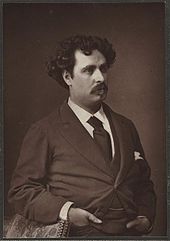Mariano Fortuny (fashion designer)
Mariano Fortuny y Madrazo (born May 11, 1871 in Granada , † May 3, 1949 in Venice ) was a Spanish universal artist; including fashion designer , painter , sculptor , architect , interior designer , engineer and inventor .
life and work
Mariano was born the son of the Spanish painter Marià Fortuny (1838–1874) and his wife Cecilia de Madrazo (1846–1942), who also came from a family of painters. When his father died in 1875, the family moved to Paris, where his grandfather Federico de Madrazo y Kuntz lived as a painter. Mariano Fortuny showed talent and received his training from 1876 to 1885, first with James Tissot , then with Paul Baudry , Emmanuel Frémiet , Giovanni Boldini , Alfred Stevens and Jean-Léon Gérôme .
In 1889 the family settled in Venice at Palazzo Martinengo . There Fortuny exhibited his father's works and his own in the large gallery. His mother had also brought together an extensive collection of velvet , brocade , silk , taffeta and satin from Venice, Ghent and the Orient . The special color tones and combinations of the gold and silver interwoven fabrics covered with foliage or floral designs and their production aroused Fortuny's curiosity. In 1892 he bought the Palazzo Pesaro degli Orfei (today: Palazzo Fortuny ) on Campo San Beneto, which he made the center of his work. He set up a painting and photo studio, a carpentry, textile printing and dyeing shop, and a tailoring shop, where he employed a dozen women.
In collaboration with his French wife Henriette Negrin (1877–1965), an expert in natural dyes, Fortuny invented new methods of dyeing textiles by printing on fabrics and tapestries . In his designs for women's dresses, he took up forms from antiquity, among other things . Typical of the Delphos dress and the Knossos scarf is the wafer-thin, permanently pleated silk satin that changes in the light, the manufacture of which Fortuny patented in Paris in 1909. He successfully designed this type of dress as early as 1905. In addition to his workshop in San Marco, the company Società Anonima Fortuny was founded in 1919 , a silk fabric printing company on the island of Giudecca .
In 1911, Fortuny exhibited his fabrics at the Exposition Internationale des Arts Décoratifs et industriels modern in the Louvre , which was very popular. Shortly thereafter, he opened a boutique in Paris , and later branches in London , Madrid and, in 1929, New York City , where his models were sold. His customers in the 1920s and 1930s were Sarah Bernhardt , Luisa Casati , Isadora Duncan , Eleonora Duse and, in the United States, Lillian Gish , Martha Graham and Ruth St. Denis . As an interior designer, he furnished the house of Consuelo Vanderbilt in Art Nouveau and Art Deco styles , as well as the salons of Marie-Laure de Noailles and Dina Galli and the gaming room of the new Hotel Excelsior in Paris. Fortuny registered more than fifty patents as an inventor, has been dealing with indirect lighting effects in the theater since the turn of the century (Fortuny GmbH AEG Berlin), designed theater sets and costumes and was also represented as a painter at all Venice Biennials until 1942 .
Mariano Fortuny y Madrazo died of a heart attack and was buried in the Campo di Verano cemetery in Rome .
Awards
- 1915 Deputy Honorary Consul of Spain in Venice
literature
- Delphine Delvaux: Fortuny - Fashion Memoir , Thames & Hudson Ltd (1998) ISBN 0-500-01846-4
- Anne-Marie Descholdt and Doretta Davanzo Poli: Mariano Fortuny - Un magicien de Vinise , Paris; Editions du Regard (1979)
- Jean Autret: L'influence de Ruskin sur la vie, les idées et l'œuvre de Marcel Proust , Librairie Droz, Genève / Lille (1955)
- AS Byatt: Peacock and Vine. On William Morris and Mariano Fortuny, Knopf Doubleday, New York (2016)
Web links
- Fortuny's Venetian Influence
- Biography - Mariano Fortuny y Madrazo (1871-1949) (English)
- Biography - Mariano Fortuny (Spanish)
- Fortuny's “Delphos” Gown (English)
- Delpho's silk dress, an iconic dress
- Exhibition: Henriette Fortuny - Portrait of a muse (English and Italian)
- Portrait of Henriette Nigrin, around 1915 ( Memento from November 15, 2008 in the Internet Archive )
- Berliner Zeitung - In the paradise of wrinkles
| personal data | |
|---|---|
| SURNAME | Fortuny, Mariano |
| ALTERNATIVE NAMES | Fortuny y Madrazo, Mariano |
| BRIEF DESCRIPTION | Italian universal artist; among others fashion designer, painter, sculptor, architect, interior decorator, engineer and inventor |
| DATE OF BIRTH | May 11, 1871 |
| PLACE OF BIRTH | Granada |
| DATE OF DEATH | May 3, 1949 |
| Place of death | Venice |

